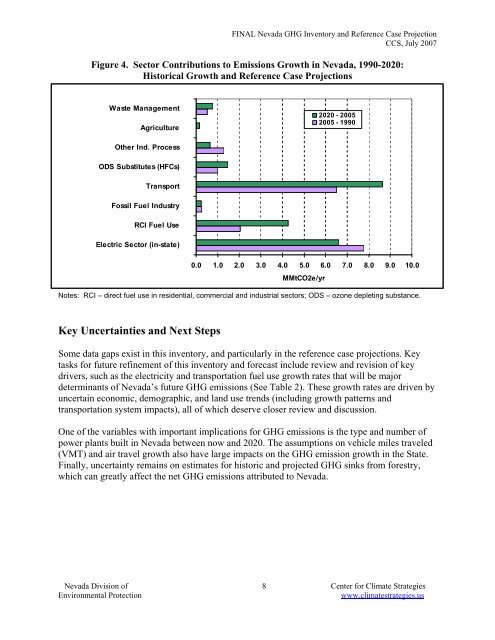Nevada Greenhouse Gas Inventory and Reference Case Projections
Nevada Greenhouse Gas Inventory and Reference Case Projections
Nevada Greenhouse Gas Inventory and Reference Case Projections
Create successful ePaper yourself
Turn your PDF publications into a flip-book with our unique Google optimized e-Paper software.
FINAL <strong>Nevada</strong> GHG <strong>Inventory</strong> <strong>and</strong> <strong>Reference</strong> <strong>Case</strong> Projection<br />
CCS, July 2007<br />
Figure 4. Sector Contributions to Emissions Growth in <strong>Nevada</strong>, 1990-2020:<br />
Historical Growth <strong>and</strong> <strong>Reference</strong> <strong>Case</strong> <strong>Projections</strong><br />
Waste Management<br />
Agriculture<br />
2020 - 2005<br />
2005 - 1990<br />
Other Ind. Process<br />
ODS Substitutes (HFCs)<br />
Transport<br />
Fossil Fuel Industry<br />
RCI Fuel Use<br />
Electric Sector (in-state)<br />
0.0 1.0 2.0 3.0 4.0 5.0 6.0 7.0 8.0 9.0 10.0<br />
MMtCO2e/yr<br />
Notes: RCI – direct fuel use in residential, commercial <strong>and</strong> industrial sectors; ODS – ozone depleting substance.<br />
Key Uncertainties <strong>and</strong> Next Steps<br />
Some data gaps exist in this inventory, <strong>and</strong> particularly in the reference case projections. Key<br />
tasks for future refinement of this inventory <strong>and</strong> forecast include review <strong>and</strong> revision of key<br />
drivers, such as the electricity <strong>and</strong> transportation fuel use growth rates that will be major<br />
determinants of <strong>Nevada</strong>’s future GHG emissions (See Table 2). These growth rates are driven by<br />
uncertain economic, demographic, <strong>and</strong> l<strong>and</strong> use trends (including growth patterns <strong>and</strong><br />
transportation system impacts), all of which deserve closer review <strong>and</strong> discussion.<br />
One of the variables with important implications for GHG emissions is the type <strong>and</strong> number of<br />
power plants built in <strong>Nevada</strong> between now <strong>and</strong> 2020. The assumptions on vehicle miles traveled<br />
(VMT) <strong>and</strong> air travel growth also have large impacts on the GHG emission growth in the State.<br />
Finally, uncertainty remains on estimates for historic <strong>and</strong> projected GHG sinks from forestry,<br />
which can greatly affect the net GHG emissions attributed to <strong>Nevada</strong>.<br />
<strong>Nevada</strong> Division of 8 Center for Climate Strategies<br />
Environmental Protection<br />
www.climatestrategies.us
















